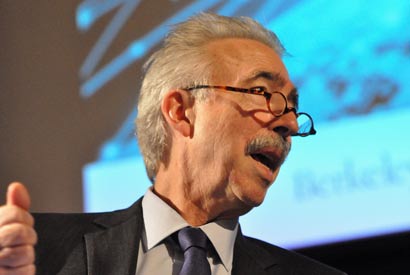Online-learning summit explores technology’s role in higher ed
More than 150 college and university administrators, professors and other from around the U.S, and as far away as Hong Kong and Tel Aviv, gathered recently at International House for the second annual Online Learning Summit. A dialogue between UC Berkeley Chancellor Nicholas Dirks and Stanford President John Hennessy was among the highlights.

March 11, 2014
Technology’s impact on teaching, and its place in the changing ecology of U.S. higher education, were among the topics explored at last week’s Online Learning Summit, held at International House. The second annual summit was co-chaired by UC Berkeley and Stanford University, with support from Massachusetts Institute of Technology and Harvard University. (The first was hosted last year on the East Coast by Harvard and MIT.)
More than 150 attendees – the majority of them college and university administrators, professors and directors – from around the U.S. and as far away as Hong Kong and Tel Aviv, gathered March 7 and 8 to hear a conversation between UC Berkeley Chancellor Nicholas Dirks and Stanford President John Hennessy; remarks by IDEO founder David Kelley; and a keynote address by Ellen Junn, provost and vice president for academic affairs at California State University, Dominguez Hills; and to attend a day’s worth of sessions on Saturday.

Online learning will be debated for years to come, Dirks and Hennessy said.
Topics included online education in K-12 classrooms, implementing online approaches, the use in academic courses of learning analytics, the economic impact of online education, how digitally mediated instruction can augment or sometimes replace residentially based instruction, and changing roles for faculty in the instructional ecosystem.
An early highlight was a Q & A exchange between Dirks and Hennessy. In their onstage chat in the Chevron Auditorium, Chancellor Dirks, as host of the event, questioned Hennessy about the value of using technology in higher education, and about the importance of preserving the residential undergraduate experience.
Hennessy said the use of technology as a supplement to traditional teaching methods (such as students listening to lectures online, rather than in class) is proving to boost students’ productivity and even increase graduation rates. Faculty members, as a consequence, have more time in class “to give more undivided attention to a student who is struggling,” he said. “That personal touch motivates a student to succeed.”
The use of technology, Hennessy added, also “makes education experiences richer” at a time when large lectures in science, for example, “aren’t working the way they used to. Laptops are open to Facebook; students are multitasking. Video can make the class more interactive.”
Online education can also be valuable, the two leaders agreed, when instructors use the technology to prepare lessons, or online tests and speedily delivered analytics to become aware of what students aren’t grasping in class. Still, while machines can help assess what a student knows,” Dirks cautioned, “it’s hard to measure students’ feelings about their education.”
“We have to create those opportunities,” said Hennessy.
The two agreed that Massive Open Online Courses (MOOCs) will continue to be valuable for specific populations, such as alumni and those who live where education is a scarce commodity. But although MOOCs are “massive,” they said, students aren’t sticking with the classes en masse, and MOOCs vary widely in their level of difficulty, as do learners’ abilities. These online courses should be tailored to abilities and settings, they said.
Hennessy said MOOCs may find a niche with communities of learners who form a “course of the month club,” take a MOOC together, and meet, as in a book club, for conversations as well as peer grading. Dirks cited another positive example of their use: Iranian women who are studying entrepreneurship together.
The two leaders agreed that the pros and cons of online learning will be part of pedagogical dialogue for years to come, and that there is no substitute for a residential undergraduate experience.